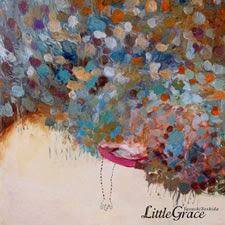Artist: Sinikka Langeland
Album: “Starflowers”
Release Date: May 28, 2007
Genre: Norwegian-Folk, Kantele-Music, Nordic-Traditions
Mood: Autumnal, Intimate, Wistful, Plaintive
Reminds Of: Eivind Aarset, Jacob Young, Arild Andersen, Susanne Abbuehl
What People Think: JazzChicago, Spirituallity&Health
Definitely Worth Buying: Amazon, CdUniverse, HbDirect
Tracklist
1. Høstnatt På Fjellskogen
2. Den Lille Fløyten
3. Sølv
4. Treet Som Vekser Opp-Ned
5. Saltstein
6. Sus I Myrull
7. Støv
8. Stjernestund
9. Langt Innpå Skoga
10. Det Er Ei Slik Natt
11. Vindtreet
12. Elghjertet
13. Har du Lyttet Til Elvene Om Natta?
ECM has always looked for new ways to interpret traditional music from different cultures. As far back as 1973, saxophonist Jan Garbarek's Triptykon used a traditional Norwegian folk song as the starting point for open-ended improvisation. More recently, British traditionalist Robin Williamson has teamed with artists normally associated with free improvisation for The Iron Stone (2007), combining original and traditional music with contemporary and centuries-old words, for some adventurous and often edgy free play that breaks down every barrier of convention in its path while remaining somehow reverent to its sources.
Born to a Norwegian father and Finnish mother, singer Sinikka Langeland is in many ways Williamson's Northern European counterpart. Her approach has gradually evolved towards original music that explores the dichotomy of her dual-lineage through more archaic forms, and the freedom of open-minded interpretation. Starflower, her ECM debut, combines her cross-cultural, cross-temporal writing with the poetry of Hans Børli. Langeland has recruited, with the additional advice of label owner/producer Manfred Eicher, a group of Scandinavian/Finnish artists commonly associated with jazz, but who have all proven themselves capable of meshing in any context. Langeland also plays the kantele, a 39-string Finnish table harp. It's a lush yet fragile sound that defines much of Starflowers as does her voice, which possesses strength equally capable of subtly delicacy.
Langeland creates narrative continuity throughout the set by using the same theme on the melancholy kantele/bass/percussion trios of "Sølv" and "Støv," the former featuring Jormin's pizzicato, the latter his arco. "Støv" leads into "Stjernestund," which begins with a percussion solo that's all color, ultimately returning to Langeland's theme from "Sølv" and "Støv" as a vocal interpretation of one of Børli's darkest yet most evocative poems.
There are moments when the ensemble approaches greater abstraction. "Elghjertet" begins in darkness, with Langeland's recitation supported by Seim and Henriksen, who continue to transform their instruments in unexpected ways. A kantele pulse finally emerges, but the approach remains free, even as the others begin to coalesce around it.
The album closes with the expansive "Hard du lyttet til elvene om natta," which melds initial melancholy with a finale of greater optimism. It's the perfect ending to an album that, in its allegiance to both modernity and antiquity, is one of ECM's most appealing explorations of seemingly disparate concepts that ultimately feel completely at home with each other.
(source: AllAboutJazz)

































